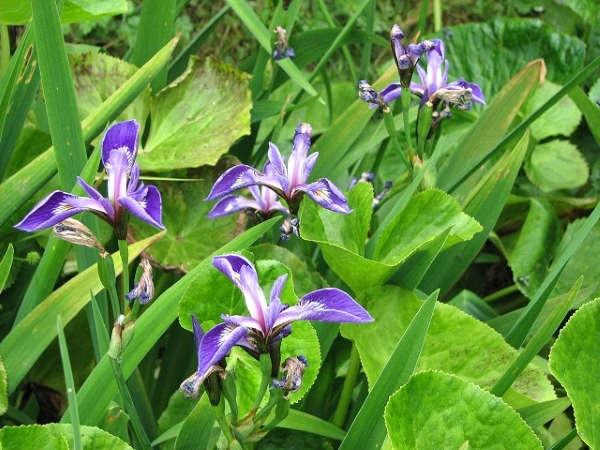
Blue Flag Iris
Botanical Name
:
Iris versicolor
Plant Type
:
Herbaceous perennial
Seasons
:
Plant in spring; blooms in late spring/early summer
Sun Level
:
Full sun (at least 6 hours of sunlight daily); tolerates partial shade
Ideal Soil Temperature for Planting
:
50-70°F (10-21°C)
Soil Type
:
Moist, well-drained soil (tolerates some clay)
Hardiness Zones
:
3–9 (USDA)
Germination
:
Seeds take at least 3 months to germinate
P.H. Level
:
Slightly acidic to neutral (6.5-7.0)
Water/Irrigation
:
Requires consistently moist soil, especially during growth and flowering
Fertilization
:
Generally not needed, but a balanced fertilizer in early spring can be beneficial
Habit
:
Clumping, spreading, upright
Propagation
:
Division (best in late summer or early fall) or seed (though slow)
Final Plant Height
:
2–4 ft
Spread
:
1–2 ft
Flowers
:
Blue to violet-blue, sometimes with yellow, white, or purple markings
Attracts
:
Bees, butterflies, hummingbirds
Uses
:
Water gardens, bog gardens, rain gardens, borders, naturalized areas
Companions
:
Other moisture-loving plants like Lobelia, Echinacea (in drier areas), and ferns
Pruning
:
Remove spent flower stalks to prevent self-seeding. Cut back foliage in fall after it dies back
Toxicity
:
Generally considered non-toxic, but may cause skin irritation in some individuals
Pests
:
Iris borers, slugs, snails
Diseases
:
Leaf spot, root rot (in poorly drained soil)
Fun Fact
:
The name “versicolor” refers to the varied colors of the flower
Confused With
:
Other Iris species, especially other blue-flowered varieties
Additional Info
:
Thrives in wet environments and is commonly found in marshes and along streams
Botanical Name
:
Iris versicolor
Plant Type
:
Herbaceous perennial
Seasons
:
Plant in spring; blooms in late spring/early summer
Sun Level
:
Full sun (at least 6 hours of sunlight daily); tolerates partial shade
Ideal Soil Temperature for Planting
:
50-70°F (10-21°C)
Soil Type
:
Moist, well-drained soil (tolerates some clay)
Hardiness Zones
:
3–9 (USDA)
Germination
:
Seeds take at least 3 months to germinate
P.H. Level
:
Slightly acidic to neutral (6.5-7.0)
Water/Irrigation
:
Requires consistently moist soil, especially during growth and flowering
Fertilization
:
Generally not needed, but a balanced fertilizer in early spring can be beneficial
Habit
:
Clumping, spreading, upright
Propagation
:
Division (best in late summer or early fall) or seed (though slow)
Final Plant Height
:
2–4 ft
Spread
:
1–2 ft
Flowers
:
Blue to violet-blue, sometimes with yellow, white, or purple markings
Attracts
:
Bees, butterflies, hummingbirds
Uses
:
Water gardens, bog gardens, rain gardens, borders, naturalized areas
Companions
:
Other moisture-loving plants like Lobelia, Echinacea (in drier areas), and ferns
Pruning
:
Remove spent flower stalks to prevent self-seeding. Cut back foliage in fall after it dies back
Toxicity
:
Generally considered non-toxic, but may cause skin irritation in some individuals
Pests
:
Iris borers, slugs, snails
Diseases
:
Leaf spot, root rot (in poorly drained soil)
Fun Fact
:
The name “versicolor” refers to the varied colors of the flower
Confused With
:
Other Iris species, especially other blue-flowered varieties
Additional Info
:
Thrives in wet environments and is commonly found in marshes and along streams
Written by Nondiah Khalayi – https://www.linkedin.com/in/nondiah-khalayi/

